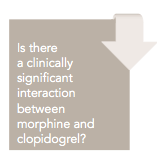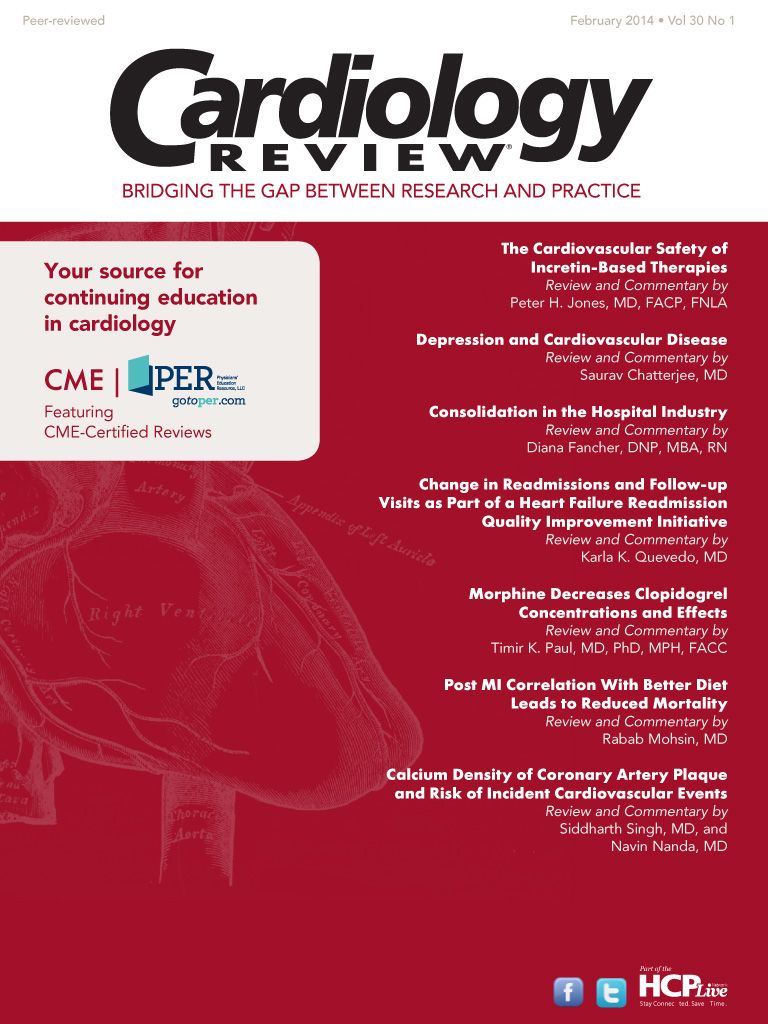Publication
Article
Cardiology Review® Online
Morphine Decreases Clopidogrel Concentrations and Effects
Author(s):
Is there a clinically significant interaction between morphine and clopidogrel?

Timir K. Paul, MD, PhD, MPH, FACC
Review
J Am Coll Cardiol.
Hobl EL, Stimpfl T, Ebner J, et al. Morphine decreases clopidogrel concentrations and effects: a randomized, double blind, placebo-controlled trial.2013. doi:0.1016/j.jacc.2013.10.068.
Study Details

This randomized, double-blind, placebo-controlled, crossover trial was conducted to assess interactions between morphine and clopidogrel, a P2Y12 receptor antagonist. Inclusion criteria for the study were nonpregnant patients aged ≥18 years of age, and able to comprehend the full nature and purpose of the study. Patients who were taking nonsteroidal anti-inflammatory drugs or platelet inhibitors, known to have coagulation disorders, relevant renal or hepatic function impairment, chronic infectious diseases (HIV, hepatitis B and C), or who had contraindications for clopidogrel or morphine, were excluded from the study.
Morphine (5 mg IV bolus) or placebo (0.9% NaCl) were administered by blinded physicians. A minimum washout period of 14 days was selected because it exceeds platelet survival in vivo and because the effect of P2Y12 inhibition diminishes within 5 days. Twenty-four healthy subjects were enrolled in the study; 12 patients were randomized to morphine and 12 patients were randomized to placebo and crossed over after a 14-day washout period. All patients received a loading dose of 600 mg clopidogrel after injection of placebo or morphine. Pharmacokinetics was determined by liquid chromatography tandem mass spectrometry and clopidogrel effects were measured by platelet function tests.
Mean age of the healthy subjects was 32 ± 9 years with a mean body mass index of 24 ± 3 kg/m².
P
P
P
P
P
P
Morphine injection delayed maximal plasma concentrations of clopidogrel (Tmax: 105 vs 83 min, morphine vs placebo; = .025) and reduced clopidogrel active metabolite (from 171 to 113 ng/mL, placebo vs morphine; = .025). Morphine diminished the total exposure, as measured by the area under the curve levels, of its active metabolite by 52% (= .001). Morphine delayed the time required for maximal inhibition of platelet aggregation on average 2-fold (3 hr vs 1.25 hr; <.001). Residual platelet aggregation was higher 1 to 4 hours after morphine injection (<.005). Morphine delayed the inhibition of platelet plug formation under high shear rates (n = 21; 75 min vs 45 min; <.004).
The authors concluded that morphine slows clopidogrel resorption and lowers the plasma levels of clopidogrel active metabolite, causing diminished effects of clopidogrel on platelets, which may decrease treatment effects in susceptible individuals.
CommentaryA Drug—Drug Interaction Between Morphine and Clopidogrel
T
he use of a combination of aspirin and P2Y12 inhibitors is the standard of care for patients with acute coronary syndrome (ACS).1,2 Clopidogrel is a P2Y12 receptor antagonist, which inhibits adenosine-diphosphate—induced platelet function.1,2 Clopidogrel is a prodrug that requires a 2—step metabolic activation by cytochrome P450 enzymes,3 which explains its relatively slow onset of action. Opiates slow gastric emptying, thereby causing delayed absorption, which may decrease peak plasma levels of oral drugs.4 Although morphine is recommended for pain relief in myocardial infarction (MI),1 there are a paucity of data from randomized controlled trials proving its net benefit. It has been shown that the use of morphine is associated with higher mortality in patients with non-ST-segment elevation MI (NSTEMI).5 Furthermore, morphine has been shown to delay the activity of prasugrel or ticagrelor in ST-segment elevation MI (STEMI) patients.6
This trial showed a potential drug—drug interaction between morphine and clopidogrel. Morphine reduced the initial plasma concentration of active metabolite by decreasing its resorption, which may negatively affect treatment in susceptible individuals. The residual platelet reactivity was significantly higher after morphine injection. Morphine decreased the concentration of active metabolite, causing a pharmacokinetic profile similar to a 300-mg loading dose despite being loaded with 600 mg7,8; this may lead to a greater risk of major adverse cardiovascular events.9 In patients who present with ACS, rapid platelet inhibition is necessary to reduce primary outcome events, as evidenced within the first hours, when prasugrel shows rapid onset of action compared with clopidogrel.10
This study included only healthy subjects and had a small sample size. Thus, I would be careful about implementing this result in ACS patients in general. Larger trials are needed that include ACS patients. Although this study showed the association of decreased efficacy of clopidogrel when coadministered with morphine, it did not determine a cause-and-effect relationship.
Until there is further evidence, the simultaneous administration of morphine and clopidogrel should be avoided when possible, such as in STEMI settings when an immediate invasive approach is the key treatment modality. If pain control is required, nitroglycerine should be used rather than morphine in this setting unless the patient presents with right ventricular infarction associated with inferior STEMI. If delayed PCI or a late invasive strategy is used during NSTEMI, morphine still would be used if necessary. But nitroglycerine would be the initial drug of choice for all patients with cardiac chest pain.
It has been shown that the onset of platelet inhibition is delayed with prasugrel and ticagrelor in patients undergoing primary percutaneous coronary intervention, and that morphine further diminishes the effect of platelet inhibition when simultaneously used with these agents.6 The data indicate that this association of decreased efficacy of platelet inhibition is not limited to clopidogrel but is also applicable to other potent P2Y12 inhibitors. Therefore, more potent P2Y12 inhibitors such as prasugrel or ticagrelor may not be alternatives and may not provide greater efficacy with concomitant administration of morphine, although more evidence is needed in this regard.
In patients already taking clopidogrel, morphine can be used with less concern, as the drug is already in the system. But patients who are naïve to clopidogrel would be the vulnerable individuals who are having MI and may require morphine for pain relief as well as immediate higher platelet inhibition. We may still have to use morphine in a few patients who are having crushing chest pain. But if such patients can be immediately taken to the catheterization lab, we would minimize the use of morphine. In any event, if patients have such severe, uncontrolled chest pain while on maximal medical management including nitroglycerine, an immediate invasive approach is indicated.
Physicians should be aware of the association of platelet inhibition with P2Y12 antagonists and morphine. The best approach would probably be to minimize the use of morphine in patients with coronary ischemia and use nitroglycerine when needed.
References
J Am Coll Cardiol.
1. O’Gara PT, Kushner FG, Ascheim DD, et al. 2013 ACCF/AHA guideline for the management of ST-elevation myocardial infarction: a report of the American College of Cardiology Foundation/American Heart Association Task Force on Practice Guidelines. 2013;61:e78-e140.
J Am Coll Cardiol.
2. Anderson JL, Adams CD, Antman EM, et al. 2012 ACCF/AHA focused update incorporated into the ACCF/AHA 2007 guidelines for the management of patients with unstable angina/non-ST-elevation myocardial infarction: a report of the American College of Cardiology Foundation/American Heart Association Task Force on Practice Guidelines. 2013;61:e179-e347.
J Am Coll Cardiol.
3. Bates ER, Lau WC, Angiolillo DJ. Clopidogrel-drug interactions. 2011;57:1251-1263.
Br J Clin Pharmacol.
4. Nimmo WS, Heading RC, Wilson J, Tothill P, Prescott LF. Inhibition of gastric emptying and drug absorption by narcotic analgesics. 1975;2:509-513.
Am Heart J
5. Meine TJ, Roe MT, Chen AY et al. Association of intravenous morphine use and outcomes in acute coronary syndromes: results from the CRUSADE Quality Improvement Initiative. . 2005;149:1043-1049.
J Am Coll Cardiol.
6. Parodi G, Valenti R, Bellandi B, et al. Comparison of prasugrel and ticagrelor loading doses in ST-segment elevation myocardial infarction patients: RAPID (Rapid Activity of Platelet Inhibitor Drugs) primary PCI study. 2013;61:1601-1606.
J Pharm Biomed Anal.
7. Takahashi M, Pang H, Kawabata K, Farid NA, Kurihara A. Quantitative determination of clopidogrel active metabolite in human plasma by LC-MS/MS. 2008;48:1219-1224.
Clin Pharmacol Ther.
8. Farid NA, Payne CD, Small DS, et al. Cytochrome P450 3A inhibition by ketoconazole affects prasugrel and clopidogrel pharmacokinetics and pharmacodynamics differently. 2007;81:735-741.
Heart.
9. Siller-Matula JM, Huber K, Christ G, et al. Impact of clopidogrel loading dose on clinical outcome in patients undergoing percutaneous coronary intervention: a systematic review and meta-analysis. 2011;97:98-105.
N Engl J Med.
10. Wiviott SD, Braunwald E, McCabe CH, et al. Prasugrel versus clopidogrel in patients with acute coronary syndromes. 2007;357:2001-2015.
About the Author
T
imir
K. P
aul
, MD, P
h
D, MPh, FACC
, is Assistant Professor, Division of Cardiology, Department of Medicine, and Director of Cardiac Rehabilitation and Prevention at Quillen College of Medicine, East Tennessee State University, Johnson City, TN. He received his MD from Dhaka Medical College, University of Dhaka, Dhaka, Bangladesh, and his PhD and MPH degrees from Tulane University. Dr Paul did his fellowship in cardiology at Ochsner Clinic, New Orleans, LA, and in interventional cardiology at the University of North Carolina, Chapel Hill. He has published many original research articles and reviews.






